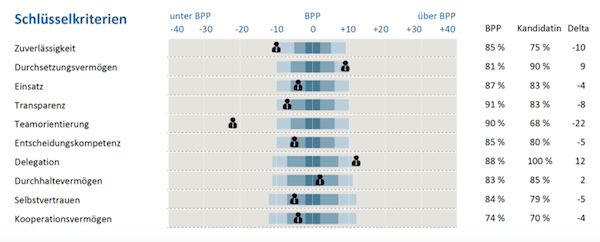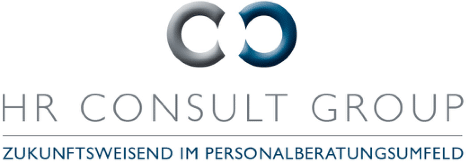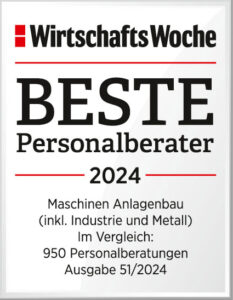Many personality traits are scrutinized as part of aptitude diagnostics. The so-called key criteria are particularly important.
The question often arises as to which requirements a candidate absolutely must fulfill in order to successfully meet the demands of a position. Or which personality traits are decisive for the success or failure of a job holder. The key criteria from aptitude diagnostics provide answers to these questions.
In contrast to the criteria that are defined as key criteria by superiors or personnel developers for the respective positions, the key criteria of the HR Consult Group AG aptitude diagnostics are derived from the most significant characteristics of the available comparison group.
The 10 key criteria of a standard or best practice profile are generated from the results of the group itself. These are the ones that show the least variation. This is where the level of agreement is highest.

The evaluations of the test results for the various characteristics each show different scatter (see sample evaluation above), i.e. the range of test results varies from characteristic to characteristic. This is due to the fact that the test person in a comparison group assesses the individual characteristics differently.
The decisive factor here is that the bandwidth / spread of the characteristic is very narrow, i.e. the test person forms an almost identical assessment on this topic and therefore agrees with the comparison group that this characteristic is significant for this occupational group in precisely this form. This means that personality traits with the lowest variance / range become the key criterion for the respective position- or occupation-specific norm or best-practice group.
Key criteria therefore have the highest significance (meaningfulness). These are checked using the values of the standard deviations. If the standard deviation is low, the dispersion caused by the values of the various tests is also low. This means that the values are closer to the mean value. This results in a narrower range and therefore a clearer and more significant characteristic, which is referred to as the key criterion.
If a candidate's result value lands within the colored bandwidth, as shown in the example above, the candidate is within the comparison profile. If the result is lower, i.e. to the left of the spread of the comparison group, the candidate has a clearly different assessment of this characteristic than the comparison group. In this case, it should be specifically questioned why the candidate assesses themselves in this way. This is usually a characteristic with development potential.
If the candidate's result lies to the right of the colored bandwidth, they consider themselves to be stronger than the comparison group in this point, which generally does indeed represent a strength. The percentages shown on the far right indicate the exact values of the average of the comparison group, the candidate's score and the delta calculated from this, i.e. the exact deviation from the average of the comparison group.
The key criteria can be sorted according to the degree of significance. Depending on the chosen procedure, a number of criteria are then selected and evaluated as key criteria. Various methods are conceivable and can be sensibly implemented:
On the one hand, a fixed number of criteria can be tapped, e.g. the first five or ten criteria. On the other hand, a percentage number can also be defined, so that, for example, 20% of all criteria are regarded as key criteria that have the lowest variance.
The big insight is that the key criteria for the successful performance of a position are self-evident and do not have to be determined in laborious coordination processes with the specialist and HR departments.
The next article in our series deals with soft skills, which are almost identical in a successful professional group.
About the author

After studying automotive engineering and industrial engineering, he began his professional career in the automotive industry in the areas of sales, development and marketing and also spent a year in Japan with one of the largest automotive suppliers.
He then moved to a globally renowned premium car manufacturer, where he was responsible for product marketing in Japan and South America and for marketing strategy in North and South America.
In 1994, he decided to become self-employed and founded a personnel consultancy in Munich, where he has been driving development and expansion for over 20 years. As Managing Director, his industry focus is naturally on the automotive world as well as mechanical and plant engineering.
His doctorate in the field of aptitude diagnostics ideally rounds off his areas of expertise, particularly with regard to personnel and management consulting. The dissertation deals with the identification and verification of typical personality traits of engineers as well as the definition of development areas for a successful professional career.
These are scientifically derived and presented in the book "Eignungsdiagnostik im Praxiseinsatz".
At the same time, his focus is on the development of networks and cooperation models as well as the continuous further development of systems and processes in personnel consulting.
Over the last 20 years in personnel consulting, he has developed several brands that are still operating successfully on the market today.




